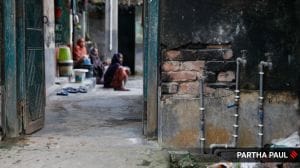Explained: Russia’s fight for Sievierodonetsk, and its parallels with Mariupol
As the fighting continues in the Russia-Ukraine war, it has emerged that the situation in Sievierodonetsk could turn out to be similar to that of Mariupol in the past few months.
 Smoke rises after a military strike on a compound of Sievierodonetsk's Azot Chemical Plant, amid Russia's attack on Ukraine, Lysychansk, Luhansk region, Ukraine June 10, 2022. (Reuters)
Smoke rises after a military strike on a compound of Sievierodonetsk's Azot Chemical Plant, amid Russia's attack on Ukraine, Lysychansk, Luhansk region, Ukraine June 10, 2022. (Reuters)As the Russia-Ukraine war crosses over 100 days, the battlefront has shifted from Kyiv, Kharkiv and Mariupol to the eastern city of Sievierodonetsk in the strategically significant Donbas region.
Donbas, an industrial region comprising of Luhansk and Donetsk provinces, is partially under the control of Russia-backed rebel fighters. Since May, the fighting has focused on Sievierodonetsk, a city in Luhansk province around 140 km away from the nearest Russian border. It is home to several production plants, chemical and machine-building factories. As of June 15, 80 per cent of the city is reportedly under Russian control.
What we know of Sievierodonetsk’s Azot factory
In Sievierodonetsk, as the Russian troops advance nearer to its goal of occupying the whole city, hundreds of civilians, including children and the elderly, have taken refuge in the city’s huge Azot chemical plant. Also known as the Sievierodonetsk Azot Association, the plant is owned by Group DF’s OSTCHEM holding. It is one of the group’s four mineral fertiliser producers in Ukraine, along with the Azot plant in Cherkasy, the Concern Stirol plant in Horlivka and the Rivne Azot in Rivne, according to the official website.
In a statement issued on June 9, Group DF said that the factory was shelled repeatedly, resulting in damage at “at least two workshops of the chemical enterprise including a major one, i.e. 1-Б ammonia production facility”.
Governor of Luhansk Serhiy Haidai said a huge fire erupted at Azot plant overnight, telling Ukrainian TV that the blaze began after a leak of tonnes of oil from radiators damaged during Russian shellinghttps://t.co/PAiZ4D1RJB pic.twitter.com/lNmEUX9d6v
— Sky News (@SkyNews) June 12, 2022
“No discharge of toxic elements into the environment was recorded, as all the fertilizers and chemicals were removed from the territory of the enterprise on the 2nd day of the war,” it said in a press release, after speculation emerged of leakage of harmful raw materials, including ammonia.
The group’s communication head framed the attack as an attempt to disrupt the grain and fertilizer exports by attacking the Nika-Tera seaport, a medium-sized seaport located in the Black Sea. The port offers services in storing and shipping of grain cargos, mineral fertilisers, liquid bulk cargos, packaged-piece cargos, and vegetable oils of sunflower, rapeseed and soya, among others.
“This is not just an aggressive attempt to seize the territory of Sievierodonetsk. This is a barbaric attempt to undermine food security. They knowingly attack our Nika-Tera seaport, which is a major grain terminal, and hit a fertilizer manufacturer. We face a planned, cynical instigation of a food crisis on a global scale. Ukraine will not be affected by the food crisis, as the country produces much more food than is needed. Indeed, they seek to provoke the global food crisis,” said Oleg Arestarkhov, Head of Corporate Communications, Group DF in an official statement.
Parallels with Mariupol siege
As fighting continues, it has emerged that the situation in Sievierodonetsk could turn out to be similar to that of Mariupol in the past few months. In May, hundreds of civilians and fighters who were holed up in the city’s sprawling Azovstal steelworks plant had laid down arms and surrendered to the Russian forces after weeks of desperate resistance.
📽️ “Last day at #Azovstal” by #Mariupol defender @Kozatsky_D#StandWithUkraine️ 🇺🇦 #StandUpForUkraine#ArmUkraineNow pic.twitter.com/D7syLzXtoh
— MFA of Ukraine 🇺🇦 (@MFA_Ukraine) May 21, 2022
The surrender — though Ukraine refused to term it as such — had been touted as a rare victory for Russian President Vladimir Putin. However, it had sparked concerns over the conditions of surrendered Ukrainian troops, many of whom were reportedly sent to a Russian prison colony.
What next?
As was done in Mariupol, attempts are being made to evacuate civilians from Sievierodonetsk via a humanitarian corridor, though it remains to be seen how successful that attempt would be. In Mariupol, several attempts to establish safe passage for civilians failed after the ceasefire was broken due to various issues. On Wednesday, Russia said it had opened a humanitarian corridor from Azot to allow civilians to escape the territory it controls and accused Ukraine’s forces of using civilians as human shields, which Kyiv has denied.
 A man holds his baby inside Azot chemical plant’s bomb shelter, where people have been hiding from shelling since the beginning of the war, in Sievierodonetsk, Luhansk region, Ukraine, April 16, 2022. (Reuters)
A man holds his baby inside Azot chemical plant’s bomb shelter, where people have been hiding from shelling since the beginning of the war, in Sievierodonetsk, Luhansk region, Ukraine, April 16, 2022. (Reuters)
Meanwhile, Russia on Monday called on the Ukrainian troops holed up in a Sievierodonetsk chemical plant to lay down their arms. Russian news agency Interax reported that the head of the country’s National Defence Management Centre asked the fighters to “stop their senseless resistance and lay down arms” from 8 am Moscow time (0500 GMT). However, Ukrainian troops ignored this ultimatum.
The city’s mayor, Oleksandr Stryuk, said Ukrainian troops were still defending the city, even though all of its river bridges had been destroyed, reported news agency Reuters.
While the exact number of those sheltering in the plant is unknown, Ukraine puts the number at over 500 civilians, including 40 children, besides soldiers. However, the separatists in the area said the actual number is over double the official estimates, claiming over 1,200 civilians may be inside, said the Reuters report.



- 01
- 02
- 03
- 04
- 05



































